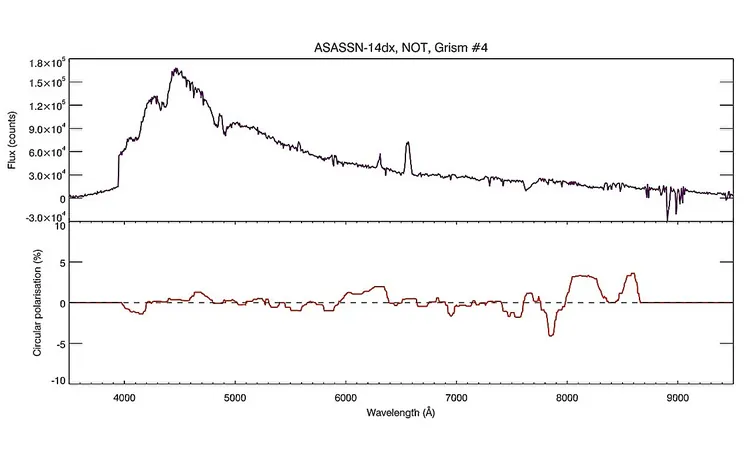
Astronomers Discover a Massive Pulsating White Dwarf in Cataclysmic Variable ASASSN-14dx!
2025-04-15
Author: William
Revolutionary Findings from the Stars!
An ambitious international team of astronomers has made a groundbreaking discovery about ASASSN-14dx, a cataclysmic variable system, revealing that it boasts a massive pulsating white dwarf at its core. The exciting results of their optical photometric, polarimetric, and spectroscopic observations were unveiled on April 9.
What are Cataclysmic Variables?
Cataclysmic variables (CVs) are fascinating binary star systems featuring a white dwarf that siphons material from a companion star. This dramatic interaction leads to unpredictable surges in brightness, followed by rapid declines back to a tranquil state.
ASASSN-14dx: A Star Up Close!
Identified in 2014, ASASSN-14dx is one of the closest cataclysmic variables to our planet, located around 265 light years away. Its orbital dance is remarkably quick, with a period of approximately 82.8 minutes, making it an intriguing subject for further examination.
A Closer Look at the Pulsating Mystery!
To unravel the mysteries of ASASSN-14dx, a dedicated group of astronomers, led by Pasi Hakala from the University of Turku in Finland, turned to multiple ground-based observatories, including the Nordic Optical Telescope (NOT). Their comprehensive studies revealed not only the orbital period but also notable pulsation periods—specifically around four and 14 minutes.
The Science of Variability!
The new observations suggest that ASASSN-14dx exhibits intricate optical variability, likely due to the presence of a massive white dwarf displaying non-radial pulsations. This is an astonishing revelation, highlighting the complex dynamics at play.
Stellar Mass and Temperatures!
The team estimates that the mass of the white dwarf is an impressive 1.1 solar masses, with an effective temperature peaking at about 16,140 K—higher than any previously detected accreting white dwarf pulsator. This raises intriguing questions about its formation: was it born massive, or did it accumulate significant mass over its lifespan?
Limits of Stellar Growth!
Importantly, the study indicates that the secondary star lacks sufficient mass to push the white dwarf past the Chandrasekhar limit—the threshold beyond which a white dwarf collapses under its own gravity. This crucial detail adds to our understanding of stellar evolution within these binary systems.
What's Next?
The researchers have called for near-infrared circular polarimetric observations to further investigate the potential magnetic properties of the white dwarf in ASASSN-14dx. The exploration of this cataclysmic variable paves the way for deeper insights into the complexities of stellar systems!









 Brasil (PT)
Brasil (PT)
 Canada (EN)
Canada (EN)
 Chile (ES)
Chile (ES)
 Česko (CS)
Česko (CS)
 대한민국 (KO)
대한민국 (KO)
 España (ES)
España (ES)
 France (FR)
France (FR)
 Hong Kong (EN)
Hong Kong (EN)
 Italia (IT)
Italia (IT)
 日本 (JA)
日本 (JA)
 Magyarország (HU)
Magyarország (HU)
 Norge (NO)
Norge (NO)
 Polska (PL)
Polska (PL)
 Schweiz (DE)
Schweiz (DE)
 Singapore (EN)
Singapore (EN)
 Sverige (SV)
Sverige (SV)
 Suomi (FI)
Suomi (FI)
 Türkiye (TR)
Türkiye (TR)
 الإمارات العربية المتحدة (AR)
الإمارات العربية المتحدة (AR)